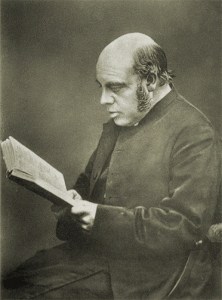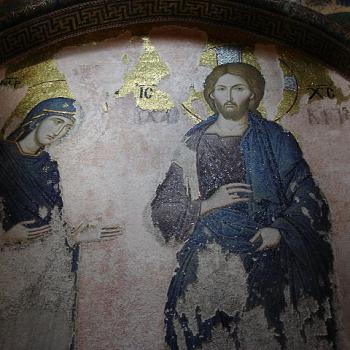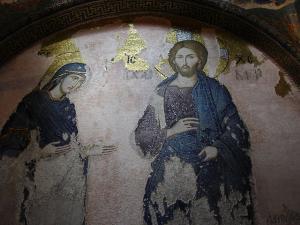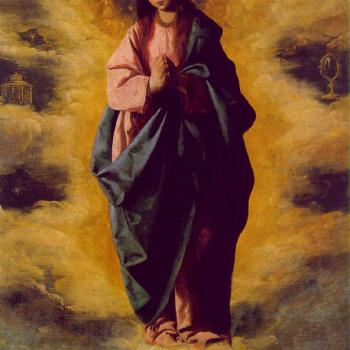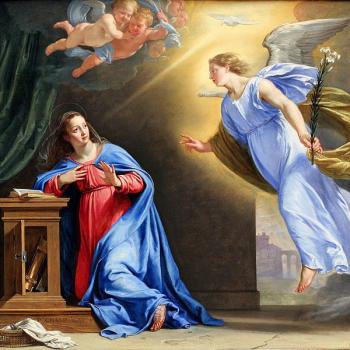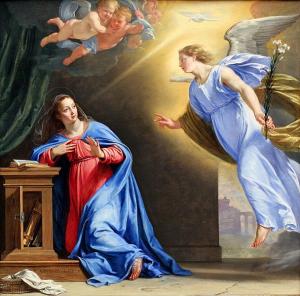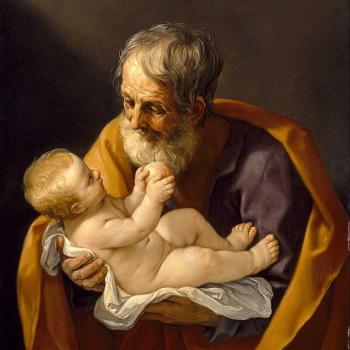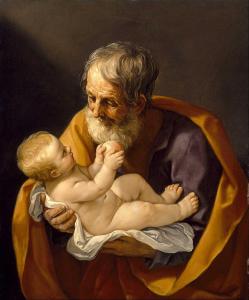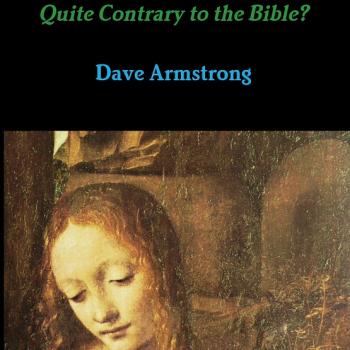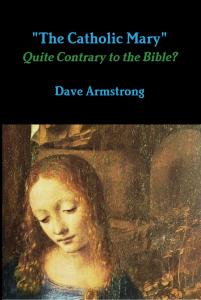Was Mary Full of Grace and Therefore Sinless? And If So, Was This Necessary or Only “Fitting”?
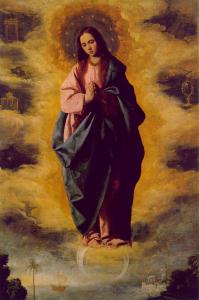
Lucas Banzoli is a very active Brazilian anti-Catholic polemicist, who holds to basically a Seventh-Day Adventist theology, whereby there is no such thing as a soul that consciously exists outside of a body, and no hell (soul sleep and annihilationism). This leads him to a Christology which is deficient and heterodox in terms of Christ’s human nature after His death. He has a Master’s degree in theology, a degree and postgraduate work in history, a license in letters, and is a history teacher, author of 25 books, as well as blogmaster (but now inactive) for six blogs. He’s active on YouTube.
This is my 21st refutation of articles written by Lucas Banzoli. As of yet, I haven’t received a single word in reply to any of them (or if Banzoli has replied to anything, anywhere, he certainly hasn’t informed me of it). Readers may decide for themselves why that is the case. His words will be in blue. I use RSV for the Bible passages unless otherwise indicated.
*****
I’m replying to Lucas’ article, “Maria pecou?” [Did Mary sin? ] (2-5-15).
Yes, [Mary] sinned. If all have sinned (Rom.3:23; 5:12), Mary has sinned. Case closed.
It’s not case closed at all. I dealt with this in my article, “All Have Sinned” vs. a Sinless, Immaculate Mary? [1996; revised and posted at National Catholic Register on 12-11-17]. I addressed the issue that “all” in Scripture often does not mean “absolutely every, without exception.” Mary’s sinlessness is not a logical impossibility, or absolutely ruled out based on the meaning of pas [“all”] alone.
To give three quick examples of what I am talking about: Paul writes that “all Israel will be saved,” (Rom 11:26), but we know that many will not be saved. And in Romans 15:14, Paul describes members of the Roman church as “filled with all knowledge”, which clearly cannot be taken literally. 1 Corinthians 15:22 states: “For as in Adam all die, so also in Christ shall all be made alive.” As far as physical death is concerned (the context of 1 Cor 15), not “all” people have died (e.g., Enoch: Gen 5:24; cf. Heb 11:5; Elijah: 2 Kings 2:11). Likewise, “all” will not be made spiritually alive by Christ, as some will choose to suffer eternal spiritual death in hell.
But I think an even more effective explanation is the following:
Mary was included in the “all” in the sense that she certainly would have been subject to original sin [and almost certainly would have actually sinned] like all the rest of us but for God’s special preventive act of grace – a “preemptive strike,” so to speak. This is why she can rightly say that God was her Savior too (Lk 1:47). . . .
[This] allows one to take “all” here in its most straightforward, common sense meaning, but with the proviso that Mary was spared from inevitable sin by means of a direct, extraordinary intervention of God, . . .
1. Mary never sinned, because her womb gave birth to an immaculate person.
And? If Mary is immaculate, then Mary’s mother’s womb also produced an immaculate person, but Catholic apologists do not claim that Mary’s mother is immaculate either. If this “logic” were minimally followed, it would lead us to Eve:
• Every immaculate being can only be generated by another immaculate being.
• Mary is immaculate for generating a sinless being.
• Mary, as a sinless being, could only then be generated by another sinless being.
• Mary’s mother, therefore, was also immaculate.
• But if Mary’s mother was immaculate and only sinless people can beget immaculate beings, then Mary’s mother’s mother was immaculate too.
• But if Mary’s mother’s mother was immaculate, then…
We already know what this will lead to, in papist “logic.” Do not try to reason with papists too much; otherwise the heads of these “apologists” will explode. This is the sort of reasoning we see from someone who lets the pope reason for them.
This is ludicrous: as is Lucas’ entire article; clueless, out to sea. And it is all these things because this is not how the Catholic Church understands or defends the Immaculate Conception of Mary in the first place. Hence my title. It’s a straw man. Lucas can go out and find Catholic apologists (real and credentialed or so-called / self-proclaimed) who make arguments like this, but so what? What does that prove? It only establishes that:
1) these particular people don’t know what they are talking about,
and
2) they aren’t familiar with how the Church explains this doctrine.
In other words, they’re as ignorant as Lucas is about Catholic Mariology. Consequently, all Lucas “proves” by silly pseudo-“arguments” like this is that there are misinformed or downright ignorant Catholics out there who unwillingly misrepresent Holy Mother Church and Catholic Mariology alike. One can always find such people in any religious group. And this is why one must always document from official ecclesiastical sources.
It’s easy enough to do so. Catholicism teaches that Mary’s Immaculate Conception was not necessary in order for her to bear the incarnate God in the virgin birth. She wasn’t required to be without sin in order to be Jesus’ mother. Rather, the Church teaches that it was appropriate or “fitting” for this to be the case. Mary herself became immaculate, not because of her mother or any other ancestor, but because God chose to perform a special miracle of grace in her case, at the moment of her conception.
It had nothing to do — strictly speaking — with anyone else. Mary herself couldn’t even participate in it since it was at the instant of her conception. Here are actual official, relevant Catholic documents concerning this, rather than “apologetic old wives’ tales”:
Blessed Pope Pius IX, in his 1854 declaration on the Immaculate Conception (Ineffabilis Deus) wrote:
For it was certainly not fitting that this vessel of election should be wounded by the common injuries, since she, differing so much from the others, had only nature in common with them, not sin. In fact, it was quite fitting that, as the Only-Begotten has a Father in heaven, whom the Seraphim extol as thrice holy, so he should have a Mother on earth who would never be without the splendor of holiness.
The Catechism teaches the same:
#722 The Holy Spirit prepared Mary by his grace. It was fitting that the mother of him in whom “the whole fullness of deity dwells bodily” should herself be “full of grace.” She was, by sheer grace, conceived without sin as the most humble of creatures, the most capable of welcoming the inexpressible gift of the Almighty. . . .”
This thinking goes back at least as far as St. Anselm (1034-1109). In his treatise On the Virginal Conception, he expounded the principle on which the doctrine rests in the following words: “It was fitting that the conception of that man (Christ) should be accomplished from a most pure mother. For it was fitting that that Virgin should be resplendent with such a purity, . . .”
2. Mary never sinned, because blessed was the fruit of her womb.
[. . .]
• The law of Deuteronomy 28 says of those who fulfill it that blessed would be the fruit of her womb.
• Mary was told that “blessed is the fruit of her womb”.
• Therefore, Mary never sinned.
This is as silly and insubstantial as Lucas’ first “argument.” Being “blessed” has no intrinsic relationship with a supposed or possible sinlessness. So it’s simply one huge non sequitur (utterly irrelevant consideration), and as such, deserves no further attention. As his source for this ridiculous argument, Lucas cites a comedian (!). This is supposed to be impressive or compelling? I guess that’s highly “fitting”: since his entire article is a joke and a farce.
3. Mary never sinned because she is the perfect tabernacle.
Believe it or not, there are Catholics going around propagating the idea that Mary is the perfect tabernacle of Hebrews 9:11, which says: “But when Christ appeared as a high priest of the good things that have come, then through the greater and more perfect tent (not made with hands, that is, not of this creation)” (RSV)
This is yet another variant of #1 and #2. I’ve never heard of this wacko argument in 32 years of [real] Catholic apologetics. What informed Catholics argue is that Mary is the “ark of the new covenant”: based on several fascinating scriptural analogies. But even so, it would not be stated that this requires her to be immaculate; only that it was “fitting” for her to be.
4. Mary never sinned, because she is the ark of the covenant.
huh? What? repeat? Is Maria the ark? Really? Really?
I shouldn’t even waste time on this one, which is the most fun of all. Basically, the argument is that the ark of the covenant was a foreshadowing of Mary, because the ark was a symbol of God’s presence, and Mary was the one who begot Jesus.
I agree that he shouldn’t waste time battling straw men. He makes a fool and an ass of himself. But since he has now brought up at least an actual historic Catholic apologetic argument (congratulations!), why don’t we briefly take a look at the real analogical argument, as opposed to Lucas’ caricature of it, along with the obligatory mocking of the straw man. Here are the actual biblical passages where this notion was drawn from:
Luke 1:35 And the angel said to her, “The Holy Spirit will come upon you, and the power of the Most High will overshadow you; therefore the child to be born will be called holy, the Son of God.”
The Greek word for overshadow is episkiasei, which describes a bright, glorious cloud. It is used with reference to the cloud of transfiguration of Jesus (Mt 17:5; Mk 9:7; Lk 9:34) and also has a connection to the shekinah glory of God in the Old Testament (Ex 24:15-16; 40:34-38; 1 Ki 8:10). Mary is, therefore, in effect, the new temple and holy of holies, where God was present in a special fashion. In fact, Scripture draws many parallels between Mary, the “ark of the new covenant” and the ark of the (old) covenant:
Exodus 40:34-35 Then the cloud covered the tent of meeting, and the glory of the LORD filled the tabernacle. And Moses was not able to enter the tent of meeting, because the cloud abode upon it, and the glory of the LORD filled the tabernacle. (cf. 1 Ki 8:6-11)
The Greek Septuagint translation uses the same word, episkiasei, in this passage. There are at least four more direct parallels as well:
2 Samuel 6:9 And David was afraid of the LORD that day; and he said, “How can the ark of the LORD come to me?”
Luke 1:43 And why is this granted me, that the mother of my Lord should come to me?
2 Samuel 6:15 So David and all the house of Israel brought up the ark of the LORD with shouting, and with the sound of the horn.
Luke 1:42 and she exclaimed with a loud cry, “Blessed are you among women, and blessed is the fruit of your womb!”
* * *
2 Samuel 6:14, 16 And David danced before the LORD with all his might; and David was girded with a linen ephod. . . . King David leaping and dancing before the LORD . . .
1 Chronicles 15:29 And as the ark of the covenant of the LORD came to the city of David, Michal the daughter of Saul looked out of the window, and saw King David dancing and making merry . . .
Luke 1:44 For behold, when the voice of your greeting came to my ears, the babe in my womb leaped for joy.
* * *
2 Samuel 6:10-11 So David was not willing to take the ark of the LORD into the city of David; but David took it aside to the house of O’bed-e’dom the Gittite. And the ark of the LORD remained in the house of O’bed-e’dom the Gittite three months . . .
Luke 1:39, 56 In those days Mary arose and went with haste into the hill country, to a city of Judah, . . . And Mary remained with her about three months, and returned to her home.
Further reflection on “holy places” and “holy items” brings out the meaning of the striking parallel symbolism. The Temple and Tabernacle were holy, and this was especially the case with the holy of holies, where the ark was kept. God was said to dwell above the ark, between the two cherubim (Ex 25:22). The presence of God always imparted holiness (Duet 7:6; 26:19; Jer 2:3). The furnishings of the Tabernacle could not be touched by anyone, save a few priests, on pain of death (Num 1:51-53; 2:17; 4:15).
This was true of the holiest things, associated with God and worship of God. The high priest only entered the holy of holies once a year, on the Day of Atonement (Num 29:8). The Jews would tie a rope to his leg in case he perished from improper behavior (Lev 16:2, 13), so they could pull him out. This was true of the ark itself. Uzziah merely reached out to steady it when it was toppling over, and was struck dead (2 Samuel 6:2-7). Others died when they simply looked inside of it (1 Sam 6:19; cf. Ex 33:20).
This is how God regards people and even inanimate objects that are in close proximity to Him. Thus, it was altogether fitting that Mary, as the ark of the new covenant, Theotokos (“bearer of God”): the one who had the sublime honor of carrying God incarnate in her womb, would be exceptionally holy.
. . . it should be noted that nothing in the Bible indicates that the ark typifies anything or anyone . . . with Elijah-John there is still a biblical confirmation of the typology, while with the “ark-Mary” there is absolutely nothing.
Right. I provided four striking analogies above, that puts the lie to this claim.
And even if the ark did typify Mary because the ark carried the presence of God and Mary begat Jesus, we could do the exact same thing and spiritualize the biblical texts to the point where we are all “arks”, because Paul told us that, spiritually, Christ is formed within all Christians, not just in Mary: “My little children, with whom I am again in travail until Christ be formed in you!” (Galatians 4:19)
Indeed, God says that we are “God’s temple” because the Holy Spirit, and the Father and the Son as well, live within us. Lucas finally stumbles upon some truth, but (sorry!) it only helps the Catholic Mariological case:
1 Corinthians 3:16-17 Do you not know that you are God’s temple and that God’s Spirit dwells in you? [17] If any one destroys God’s temple, God will destroy him. For God’s temple is holy, and that temple you are.
1 Corinthians 6:17-20 But he who is united to the Lord becomes one spirit with him. [18] Shun immorality. Every other sin which a man commits is outside the body; but the immoral man sins against his own body. [19] Do you not know that your body is a temple of the Holy Spirit within you, which you have from God? You are not your own; [20] you were bought with a price. So glorify God in your body.
2 Corinthians 6:15-17 What accord has Christ with Be’lial? Or what has a believer in common with an unbeliever? [16] What agreement has the temple of God with idols? For we are the temple of the living God; as God said, “I will live in them and move among them, and I will be their God, and they shall be my people. [17] Therefore come out from them, and be separate from them, says the Lord, and touch nothing unclean;
then I will welcome you,
See how holiness and proximity to God go hand-in-hand? This is precisely the Catholic point about Mary bearing God the Son; the incarnate God. Perfect holiness is plainly highly appropriate; though not absolutely necessary, as explained. St. Paul nails down that point in his analyses of the indwelling Holy Spirit in all Christian believers, in noting that this should cause us to “shun immorality” and “glorify God in your body” and be “one spirit with him” and “come out from them, and be separate from them”: all because we are temples of the Holy Spirit.
And how is this at all inconsistent with — let alone a disproof of — the notion that it was fitting for Mary to be without sin because she bore God the Son in her body for nine months? It was because God knew that Mary would almost certainly fall into sin like all of us, but for His special act of grace at her conception, that He did that, so that she would be a perfectly holy vessel for the incarnate God: as is utterly appropriate and fitting. It’s absolutely pure “monergistic” grace. Mary knew and did absolutely nothing to receive it, because it was simultaneous with the supernatural creation of her soul and the natural, biological beginning of existence of her body. It was all God, and all grace.
Nor is it at all implausible, “unbiblical” or inconceivable. After all, it merely made Mary like Eve: without sin, and before having committed original sin. This is why the fathers and Catholics call Mary the “new Eve” or “second Eve.” The first one said “no” to God. Mary said “yes.” A sinless person or creature is not impossible. They exist on the earth today, as I write. Adam and Eve were, the unfallen angels have always been sinless, children under the age of reason (in a sense) are, as well as some who are severely mentally disabled, and indeed all of us who are granted final salvation and eternal life will be sinless in heaven.
This is the problem with interpreting the Bible in overly typological terms: we can put anything in it. Even the insanity that Mary was an ark, or that we all are.
It’s not “insanity” at all. It’s an explicit biblical analogy, expressed in several ways. Lucas thinks that is insane. Catholics take all of the Bible very seriously, rather than picking and choosing only what we personally prefer, based on an existing predisposition even before we get to Holy Scripture. And we are all “arks” in an even greater sense: being temples of God the Holy Spirit and all three Persons of the Trinity (many other passages indicate). This is all based on abundant scriptural proof.
5- Mary never sinned, because the Bible does not say that Mary sinned
Wow! What a fantastic argument! So let’s see how many people have never sinned either: [he names twenty]
It’s true that the Bible never shows Mary sinning (though various failed arguments to that end have been attempted; I have a whole section about that on my Blessed Virgin Mary web page). Absence of positive evidence would be the notoriously weak “argument from silence” (I agree). But belief in Mary’s sinlessness is based on much more than we have for these other twenty people. I have made several “Bible-Only” arguments for the sinlessness of Mary. The key is her being “full of grace” (Luke 1:28). Rightly understood, that is a positive proof that she was without sin:
Luke 1:28 (“Full of Grace”) & Immaculate Conception [2004]
The Bible: Mary Was Without Sin [4-1-09]
Mary’s Immaculate Conception: A Biblical Argument [2010]
Annunciation: Was Mary Already Sublimely Graced? [10-8-11]
Biblical Support for Mary’s Immaculate Conception [National Catholic Register, 10-29-18]
A “Biblical” Immaculate Conception? (vs. James White) [8-27-21]
As we see, Lucas gets to one of the actual Catholic arguments (Luke 1:28) next (congratulations again, for actually avoiding irrelevant and absurd straw man battles!):
6-Mary never sinned, because she was full of grace.
So Stephen also never sinned: “And Stephen, full of grace and power, did great wonders and signs among the people.” (Acts 6:8)
In that verse, the phrase is plērēs charitos [πλήρης χάριτος], not kecharitōmenē [κεχαριτωμένη], as in Luke 1:28. If the Greek terminology is different, then the argument loses most or all of its relevance and force. The perfect stem of a Greek verb [as with kecharitōmenē], denotes, according to Friedrich Blass and Albert DeBrunner, “continuance of a completed action” (Greek Grammar of the New Testament [Chicago: University of Chicago Press, 1961], 66). Mary, therefore, continues afterward to be full of the grace she possessed at the time of the Annunciation.
Nor the Corinthians: “And God is able to provide you with every blessing in abundance, so that you may always have enough of everything and may provide in abundance for every good work.” (2 Corinthians 9:8)
This gets back to the generalized and non-literal meaning of “all”: as discussed above. Lucas’ translation, rendered into English, is: “And God is able to make all grace abound to you, so that, always having all sufficiency in all things, you may abound to every good work”. But here the phrase is pasan charin [πᾶσαν χάριν], so it’s not the same as Luke 1:28, which is unique.
Nor the Ephesians: “to the praise of his glorious grace which he freely bestowed on us in the Beloved.” (Eph.1:6)
Lucas’ translation (transferred to English) reads in part: “he has filled us with grace”. In looking at about 35 English translations of Ephesians 1:6, I never see the word “filled” in any of them. In any event, it’s again a different Greek construction. According to Marvin Vincent, a well-known Protestant linguist and expert on biblical Greek, the meaning is:
. . . not “endued us with grace,” nor “made us worthy of love,” but, as “grace – which he freely bestowed.” (Word Studies in the New Testament, III, 365)
Vincent indicates different meanings for the word grace in Luke 1:28 and Ephesians 1:6. A.T. Robertson also defines the word in the same fashion, as “he freely bestowed” (Word Pictures in the New Testament, IV, 518). Here the phrase is charitos autou hēs echaritōsen [χάριτος αὐτοῦ ἧς ἐχαρίτωσεν].
As for the grace bestowed here on all believers being parallel to the fullness of grace bestowed upon the Blessed Virgin Mary, this simply cannot logically be the case, once proper exegesis is undertaken. Apart from the different meanings of the specific word used, as shown, grace is possessed in different measure by different believers, as seen elsewhere in Scripture:
2 Peter 3:18 But grow in the grace and knowledge of our Lord and Savior Jesus Christ. To him be the glory both now and to the day of eternity. Amen.
Ephesians 4:7 But grace was given to each of us according to the measure of Christ’s gift. (cf. Acts 4:33, Rom 5:20, 6:1, James 4:6, 1 Pet 5:5, 2 Peter 1:2)
The “freely bestowed” grace of Ephesians 1:6, then, cannot possibly be considered the equivalent of that “fullness of grace” applied to Mary in Luke 1:28 because it refers to a huge group of people, with different gifts and various levels of grace bestowed, as the verses just cited show. Grace is given in different measure to believers. The mass of Christian believers as a whole possess neither the same degree of grace nor of sanctity, and everyone knows this, from experience and revelation alike.
Nor the apostles: “And with great power the apostles gave their testimony to the resurrection of the Lord Jesus, and great grace was upon them all.” (Acts 4:33)
“Great” or “abundant” grace is obviously not the same as “full of grace.” Accordingly, different Greek words are again used, as in all these supposed “disproofs” of the Catholic argument from Luke 1:28: charis te megalē [χάρις τε μεγάλη]. So why does Lucas even bring this up? It’s dumb: as if he wants to maintain that a “glass that is three-quarters full” is the same as a glass that is absolutely full: to the brim.” It just doesn’t fly.
Neither do the readers of the gospel of John: “And from his fulness have we all received, grace upon grace.” (John 1:16)
Nice try but no cigar again. The Greek phrase is plērōmatos . . . charin [πληρώματος . . . χάριν]. If the Holy Spirit, Who inspired the revelation of the Bible, intended for all these passages to have the same exact meaning as Luke 1:28, then the same or equivalent words would have been used. But the fact remains that none of these other “parallels” read the same or mean the same as Luke 1:28. I’m happy to have this opportunity to clarify that and refute the failed analogies once and for all.
If Mary fulfilled all the law, Jesus would not be necessary
It is precisely because no one was able to fulfill all the law that God had to send His only begotten Son “that whoever believes in Him should not perish, but have eternal life” (Jn.3:16). If Mary, or any human being in the world, had managed to live without committing any sin, fully fulfilling all the law, and had been born without the stain of original sin, then Jesus would be unnecessary . . .
We totally agree. Mary would have been subject to original sin like all of the rest of us, and would very likely have committed actual sin, if God had not performed a special miracle of freeing her from original sin at conception. So He saved her as much as He saved the rest of us. One can save a person from a pit in two ways: by pulling him or her out of it, or by preventing him or her from ever falling into it in the first place. The “pit” here is a metaphor for sin. The Immaculate Conception is “salvation by prevention.”
For the rest of us who are to be saved, it comes by pulling us out of — redeeming or rescuing us from — the pit of sin that we were already in. That’s why Mary calls God her Savior, too: because His grace saved her just like it saved anyone else who attains salvation and makes it to heaven.
The rest of this section from Lucas is irrelevant, since he fails to understand this fundamental premise that has been discussed in theology for about a thousand years: the notion of “pre-redemption.” Catholics believe Mary was saved only by God’s grace, too: just in a different fashion. She is not “out of the pool” of those saved by Grace Alone. She was a human being like all the rest of us: whom God decreed and chose to make exceptionally holy because she was the Mother of God the Son; the “God-bearer” (Theotokos).
Lucas then repeats his “all have sinned” mantra. I already dealt with that. but here’s one specific (old, tired) aspect that I will directly reply to:
Paul said that there was no one who was completely perfect: “as it is written: “None is righteous, no, not one; [11] no one understands, no one seeks for God. [12] All have turned aside, together they have gone wrong; no one does good, not even one.”” (Romans 3:10-12)
Psalm 14:2-3 The LORD looks down from heaven upon the children of men, to see if there are any that act wisely, that seek after God. [3] They have all gone astray, they are all alike corrupt; there is none that does good, [Hebrew, tob] no not one. (cf. 53:1-3; Paul cites this in Rom 3:10-12)
Yet in the immediately preceding Psalm, David proclaims, “I have trusted in thy steadfast love” (13:5), which certainly is “seeking” after God! And in the very next he refers to “He who walk blamelessly, and does what is right” (15:2). Even two verses later (14:5) he writes that “God is with the generation of the righteous.” So obviously his lament in 14:2-3 is an indignant hyperbole and not intended as a literal utterance.
Such remarks are common to Hebrew poetic idiom. The anonymous psalmist in 112:5-6 refers to the “righteous” (Heb. tob), as does the book of Proverbs repeatedly: using the words “righteous” or “good” (11:23; 12:2; 13:22; 14:14, 19), using the same word, tob, which appears in Psalm 14:2-3. References to righteous men are innumerable (e.g., Job 17:9; 22:19; Ps 5:12; 32:11; 34:15; 37:16, 32; Mt 9:13; 13:17; 25:37, 46; Rom 5:19; Heb 11:4; Jas 5:16; 1 Pet 3:12; 4:18, etc.).
With Adam’s death, all men sinned (note: the word anthropos denotes all mankind, obviously not excluding women when saying that “all men have sinned”): “Therefore as sin came into the world through one man and death through sin, and so death spread to all men because all men sinned” (Romans 5:12)
That’s referring to original sin, which is precisely what God removed from Mary at conception. That is the miracle and essence of the Immaculate Conception.
3. The Bible only makes an exception for Jesus
Another important point is that the only person for whom the Bible makes an exception is the obvious exception: Jesus.
“For we have not a high priest who is unable to sympathize with our weaknesses, but one who in every respect has been tempted as we are, yet without sin.” (Hebrews 4:15)
“Which of you convicts me of sin? If I tell the truth, why do you not believe me?” (John 8:46)
Neither of these verses rule out the possibility of a sinless person besides Jesus. They merely assert that He was sinless. Lucas’ description of “only” is misguided. It doesn’t follow from what he presents.
Why, then, did no one make the same exception for Mary, especially considering that it was not at all obvious that she was also an exception to the rule?
One did make an exception for Mary: the angel Gabriel in Luke 1:28. He was the one who referred to her in inspired revelation as “full of grace.” And when we analyze in the Bible the notion that grace is the antithesis and overcomer of sin, we conclude that, therefore, being full of grace means being freed from and free of sin. See:
Romans 5:17, 21 If, because of one man’s trespass, death reigned through that one man, much more will those who receive the abundance of grace and the free gift of righteousness reign in life through the one man Jesus Christ. . . . [21] so that, as sin reigned in death, grace also might reign through righteousness to eternal life through Jesus Christ our Lord.
Romans 6:14 For sin will have no dominion over you, since you are not under law but under grace.
2 Corinthians 1:12 . . . holiness and godly sincerity, . . . by the grace of God.
2 Timothy 1:9 who saved us and called us with a holy calling, . . . in virtue of his own purpose and the grace which he gave us in Christ Jesus ages ago,
Lucas has a section called “Mary needed a Savior”; but he exhibits not the slightest inkling of understanding that Catholics fully agree with this (since we, too, revere the Bible as God’s inspired revelation, and read Luke 1:47 just as Protestants do), and how we reason through it. Now (if he reads this) he will understand that, so perhaps he can write a much more serious and worthy analysis next time, instead of forcing me to have to “reinvent the wheel” because he is so profoundly and inexcusably ignorant of historic and Catholic and biblical theology.
In order to be an effective apologist, one must possess this sort of basic knowledge (I’ve been doing Christian apologetics for 41 years, and specifically Catholic apologetics for 32). And until they obtain it, they ought to drop the pretense of being an informed apologist: trying to educate others. Otherwise, it’s the blind leading the blind, similar to the people St. Paul described as those “who will listen to anybody and can never arrive at a knowledge of the truth” (2 Tim 3:7), or whose “god is the belly” (Phil 3:19: one of my very favorite Bible verses!).
6. Mary could not open the seal, nor look at it
In Revelation, John sees a scroll in the form of a scroll written on both sides and sealed with seven seals. He then says:
“and I saw a strong angel proclaiming with a loud voice, “Who is worthy to open the scroll and break its seals?” [3] And no one in heaven or on earth or under the earth was able to open the scroll or to look into it, [4] and I wept much that no one was found worthy to open the scroll or to into into it. [5] Then one of the elders said to me, “Weep not; lo, the Lion of the tribe of Judah, the Root of David, has conquered, so that he can open the scroll and its seven seals.”‘” (Revelation 5:2-5)
Note that no one except Jesus was worthy to open the book or even look at it! John is quite clear in saying that the reason such people could not even look at the book is because they were not worthy of it.
First of all, this doesn’t necessarily have to do with sinlessness. Being “worthy” to do something can also be related to suitability, ability, appropriateness, etc. The word for “worthy” is axios (Strong’s word #514). It has been translated also as “appropriate” (Acts 26:20: NASB) and “fitting” (1 Cor 16:4; 2 Thess 1:3: NASB).
But beyond that preliminary consideration, Jesus opened the scroll because He was God. Lucas is looking at this passage one-dimensionally. The Ignatius Catholic Study Bible (Scott Hahn and Curtis Mitch, 2nd edition, 2010) commented on it:
Christ qualifies as the executor of the Old Covenant (Rev 5:9) with divine authority to administer its blessings and curses. The sealed book refers to Sacred Scripture, for it was opened by no one except Christ, whose death, Resurrection, and Ascension opened access to all the mysteries it contained. (p. 499)
Obviously Mary has none of those divine qualities, and so she (like every other creature) was not “worthy” to open the scroll. She can’t do what only God the Son can do. This contradicts nothing in Catholic Mariology. As the above citation vaguely alludes to, the larger passage literally explains why only Jesus could open the scroll and break the seal. It “authoritatively interprets” the passage under consideration: “Worthy art thou to take the scroll and to open its seals, for thou wast slain and by thy blood didst ransom men for God” (5:9). Isn’t it amazing how much a little biblical context clarifies things? Lucas should try it some time.
The question then becomes: why is Lucas making this issue an anti-Mary polemic, when she clearly has nothing to do with it, since the Bible itself says that Jesus had to do this since only He was “slain” in order for His “blood” to “ransom men for God” (i.e., He alone was the Redeemer and Savior)? Thus all of Lucas’ mocking and tweaking histrionics and melodramatic polemics about Catholic veneration of Mary are utterly and completely irrelevant:
Queen of Heaven, immaculate, totally without any stain of sin throughout her life, the mother of God himself(!) and the wife of the Holy Spirit(!), the helper, the intercessor, the “mother” of all Christians, the perfect “ark”, the mediatrix of graces and even co-redeemer . . . full of grace and a more important person than all the saints and all the angels put together . . .
Yes she is all that, and (duh!) none of it makes her God (not within a trillion miles), Whom alone could open this seal, per Revelation 5:9. Why does “mother of God” deserve an exclamation point, as if it is some amazing thing? Mary was Jesus’ mother and He was God. Hence, she was the “mother of God”: literally “God-bearer”: which clearly applies only to Jesus, not the Father (neither the father nor the Holy Spirit had a mother: since they are eternal and immaterial spirits). Why is this controversial? It should be only to someone who denies the Trinity or the incarnation.
“Wife of the Holy Spirit” should ruffle no feathers, either. It’s entirely biblical. Scripture speaks in terms of the bride being the Church, and makes analogies between marriage and Christ and His Church. So why should there be controversy about Mary being the spouse of the Holy Spirit? That Jesus’ conception was of the Holy Spirit as a sort of “Father” is plain in the Bible:
Matthew 1:18-20 Now the birth of Jesus Christ took place in this way. When his mother Mary had been betrothed to Joseph, before they came together she was found to be with child of the Holy Spirit; [19] and her husband Joseph, being a just man and unwilling to put her to shame, resolved to divorce her quietly. [20] But as he considered this, behold, an angel of the Lord appeared to him in a dream, saying, “Joseph, son of David, do not fear to take Mary your wife, for that which is conceived in her is of the Holy Spirit;” (cf. Lk 1:31, 34-35)
Likewise, “spouse of God” is thought to imply an equality with God, when in fact it’s only a limited analogical description based on Mary’s relation to the Holy Spirit in the matter of the conception of Jesus. This description is no more “unbiblical” or non-harmonious with scriptural thought than St. Paul saying “we are God’s fellow workers” (1 Cor 3:9; cf. 2 Cor 6:1), or St. Peter referring to men becoming “partakers of the divine nature” (2 Pet 1:4; cf. 1 Jn 3:2). These are similarly understood as not entailing equality with God. Along these lines, there are many biblical passages about Israel or the Church being the “bride” of God the Father or Jesus Christ, God the Son:
Isaiah 54:5 For your Maker is your husband, the LORD of hosts is his name; . . .
Isaiah 62:5 . . . as the bridegroom rejoices over the bride, so shall your God rejoice over you.
Jeremiah 31:32 . . . my covenant which they broke, though I was their husband, says the LORD. (cf. 3:20)
Hosea 2:16, 19-20 “And in that day, says the LORD, you will call me, `My husband,’ and no longer will you call me, `My Ba’al.’ . . . [19] And I will betroth you to me for ever; . . . (cf. 4:12; 9:1)
Matthew 9:15 And Jesus said to them, “Can the wedding guests mourn as long as the bridegroom is with them?” (cf. Mk 2:19-20; Lk 5:34-35; Mt 25:1-10)
2 Corinthians 11:2 I feel a divine jealousy for you, for I betrothed you to Christ to present you as a pure bride to her one husband.
Ephesians 5:28-29, 32 Even so husbands should love their wives as their own bodies. He who loves his wife loves himself. [29] For no man ever hates his own flesh, but nourishes and cherishes it, as Christ does the church, . . . [32] This mystery is a profound one, and I am saying that it refers to Christ and the church (cf. Rev 19:7; 21:2; 21:9)
Given all of this biblical data, saying that Mary is the “spouse of God” should not present any difficulty at all to anyone who accepts the Bible as God’s inspired revelation. The only possible objection would come from not understanding what is meant by the phrase in the first place. And as usual, that is Lucas’ problem, and that of the legion of anti-Catholic “Know-Nothings” with whom he hangs around. Willful ignorance and bigotry apparently have a very strong hold on a great number of people. I try my best to educate folks, so they can be freed from this intolerable burden and yoke that people like Lucas perpetuate. Truth is the liberator!
“E for effort” though, and thanks for the chuckles. I needed some comic relief at this point, having endured only by God’s grace the fathomless imbecilities and vapid, fatuous nonsense that relentlessly dominates this wretched effort from Lucas. Some may think I exaggerate. But I think it’s an understatement. Finally — thank heavens –, I reach the final section (thanks for your prayers for my patience!):
7. Mary recognized herself as a sinner
Another New Testament evidence that Mary did not consider herself immaculate, but saw herself as a sinner, just like all other human beings, is in Luke 2:24, which says: “and to offer a sacrifice according to what is said in the law of the Lord, “a pair of turtledoves, or two young pigeons.””
By the law the iniquity of the woman who had given birth was atoned for in this way:
“And when the days of her purifying are completed, whether for a son or for a daughter, she shall bring to the priest at the door of the tent of meeting a lamb a year old for a burnt offering, and a young pigeon or a turtledove for a sin offering, [7] and he shall offer it before the LORD, and make atonement for her; then she shall be clean from the flow of her blood. This is the law for her who bears a child, either male or female. [8] And if she cannot afford a lamb, then she shall take two turtledoves or two young pigeons, one for a burnt offering and the other for a sin offering; and the priest shall make atonement for her, and she shall be clean.” (Leviticus 12:6-8). [Lucas mistakenly had “2:6-8”]
If Mary were immaculate, the only sacrifice needed would be that of one pigeon for the holocaust, but never of the other, which was for sins. Mary, once again, shows that she recognized herself as a sinner.
The question involves the relationship of ritual uncleanliness to sin and morality. They are two different things. A Catholic priest who goes by the name of AthanasiusOfAlex explains:
In summary, in Israel, so-called “sin” offerings were offered for transgressions against the ritual law, not so much for offenses against the moral law.
Moreover, just as Jesus submitted himself to the baptism of John, even though he did not need to repent of any sins, Mary wished to fulfill the requirements of the Jewish law out of loving obedience to God.
There is, therefore, no contradiction between Mary’s sinlessness (in the moral sense) and her offering a sacrifice to remove the merely ritual impurity associated with childbirth. . . .
In ancient Israel, women were considered ritually unclean for a few weeks after the birth of her child. (It varied according to the sex of the child; a total of 40 days for a boy, and 80 days for a girl. See vv. 2-6.) That essentially meant that they were unable to partake of the liturgical celebrations until their uncleanliness was over, at which time they were to make a sin offering, or either a lamb or a pair of pigeons or turtledoves (vv. 6-8).
But it is important to note that ritual uncleanliness had nothing to do with moral uncleanliness. Leviticus chapter 4 introduces the concept of sin offerings in this way:
And the Lord spoke to Moses, saying, “Speak to the people of Israel, saying, If anyone sins unintentionally in any of the Lord’s commandments about things not to be done, and does any one of them, if it is the anointed priest who sins … [and it goes on to spell out what each group should do] (Lev. 4:1-3).
Sin offering could only be offered for unintentional transgressions and, in general for the removal of ritual uncleanliness. There was, in fact, no provision in the Law for the forgiveness of moral offenses—and this lack was one of the constant sufferings of the People of Israel. . . .
It should be observed that the Law did not make any exceptions. The moral character of the woman was never considered; all women had to make the sin offering after childbirth. . . .
Jesus did something similar when he received the baptism of John. Jesus was also sinless and (unlike Mary) incapable of sinning; and yet he received the baptism of repentance, because it was “fitting … to fulfill all righteousness” (Mt. 3:15). (“How does one reconcile the sinlessness of Mary with her sin offering in Luke 2:24?”, Christianity.StackExchange, answer given on 9-15-15)
With regard to the differentiation of moral and ritual impurities or uncleanliness in the Old Testament, in RSV, the word “unwittingly” is applied 13 times to sins where the person was unaware of having committed them. Peter Turner offered another answer on the same web page, on 5-4-18:
Archbishop Fulton Sheen addresses this in his Life of Christ. He notes that this is akin to the Circumcision of Jesus, he says these are two sides sin, one “the necessity of enduring pain to expiate for it” and the “need for purification”. He says that Jesus didn’t need to be circumcised because He was God and she didn’t need to be purified because she was conceived without sin. But, to show “this Child’s dedication to the Father was absolute, and would lead Him to the Cross” all those events took place.
Pastor Ricky Kurth, in his article, “Did Christ Offer Animal Sacrifices?” (Berean Bible Society) offers further analogies of the sinless Christ also participating in such Mosaic rituals:
[T]he Law required men to keep the seven feasts of Leviticus 23, each of which involved an animal sacrifice, and we know the Lord kept Israel’s feasts (Luke 22:15; John 7:2,10). These sacrifices were offered for the people of Israel as a whole, and He was one of the people, and so in this way He identified with them with animal sacrifices.
See also: Protestant Claim: “Mary was a Sinner Because She Offered a Sacrifice” [Kris Smith, Da Pacem Domine, 3-15-20].
I rest my case.
***
Practical Matters: Perhaps some of my 4,000+ free online articles (the most comprehensive “one-stop” Catholic apologetics site) or fifty books have helped you (by God’s grace) to decide to become Catholic or to return to the Church, or better understand some doctrines and why we believe them.
Or you may believe my work is worthy to support for the purpose of apologetics and evangelism in general. If so, please seriously consider a much-needed financial contribution. I’m always in need of more funds: especially monthly support. “The laborer is worthy of his wages” (1 Tim 5:18, NKJV). 1 December 2021 was my 20th anniversary as a full-time Catholic apologist, and February 2022 marked the 25th anniversary of my blog.
PayPal donations are the easiest: just send to my email address: [email protected]. You’ll see the term “Catholic Used Book Service”, which is my old side-business. To learn about the different methods of contributing, including 100% tax deduction, etc., see my page: About Catholic Apologist Dave Armstrong / Donation Information. Thanks a million from the bottom of my heart!
***
Photo credit: Immaculate Conception (1635), by Francisco de Zurbarán (1598-1664) [public domain / Wikimedia Commons]
***
Summary: Brazilian Protestant apologist Lucas Banzoli foolishly attacks the sinlessness of the Blessed Virgin Mary by absurdly battling several imaginary “Mariological straw men.”




